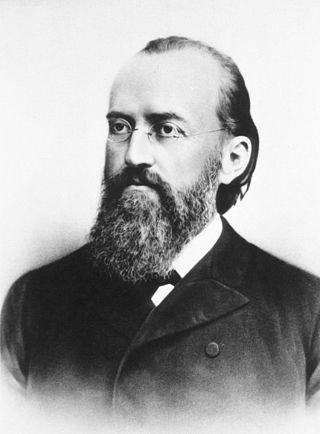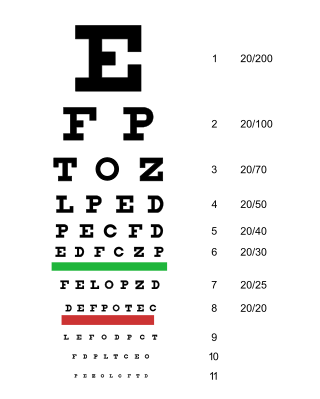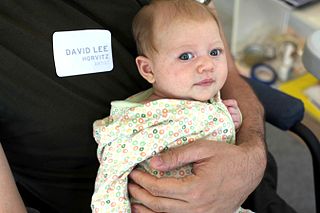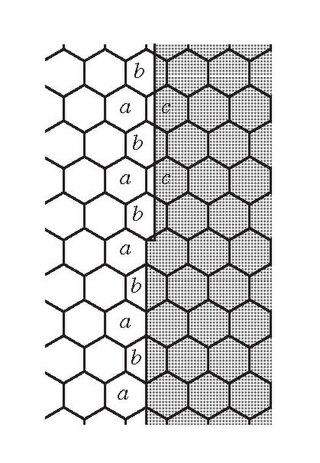
Karl Ewald Konstantin Hering was a German physiologist who did much research in color vision, binocular perception, eye movements, and hyperacuity. He proposed opponent color theory in 1892.

Visual acuity (VA) commonly refers to the clarity of vision, but technically rates a person's ability to recognize small details with precision. Visual acuity depends on optical and neural factors. Optical factors of the eye influence the sharpness of an image on its retina. Neural factors include the health and functioning of the retina, of the neural pathways to the brain, and of the interpretative faculty of the brain.
Stereopsis is the component of depth perception retrieved through binocular vision. Stereopsis is not the only contributor to depth perception, but it is a major one. Binocular vision happens because each eye receives a different image because they are in slightly different positions on one's head. These positional differences are referred to as "horizontal disparities" or, more generally, "binocular disparities". Disparities are processed in the visual cortex of the brain to yield depth perception. While binocular disparities are naturally present when viewing a real three-dimensional scene with two eyes, they can also be simulated by artificially presenting two different images separately to each eye using a method called stereoscopy. The perception of depth in such cases is also referred to as "stereoscopic depth".
Vision science is the scientific study of visual perception. Researchers in vision science can be called vision scientists, especially if their research spans some of the science's many disciplines.

In mathematics, physics, and engineering, spatial frequency is a characteristic of any structure that is periodic across position in space. The spatial frequency is a measure of how often sinusoidal components of the structure repeat per unit of distance. The SI unit of spatial frequency is cycles per meter (m). In image-processing applications, spatial frequency is often expressed in units of cycles per millimeter (mm) or equivalently line pairs per mm.

Infant vision concerns the development of visual ability in human infants from birth through the first years of life. The aspects of human vision which develop following birth include visual acuity, tracking, color perception, depth perception, and object recognition.
Gordon Ernest Legge is currently the Distinguished McKnight University Professor and former chair of the Department of Psychology at the University of Minnesota. Legge is the director of the Minnesota Laboratory for Low-Vision Research.

Perceptual learning is learning better perception skills such as differentiating two musical tones from one another or categorizations of spatial and temporal patterns relevant to real-world expertise. Examples of this may include reading, seeing relations among chess pieces, and knowing whether or not an X-ray image shows a tumor.

In the psychology of color, color preferences are the tendency for an individual or a group to prefer some colors over others, such as having a favorite color or a traditional color.
Tom Norman Cornsweet was an American experimental psychologist known for his pioneering work in visual perception, especially the effect that bears his name, and in the development of ophthalmic instrumentation.

The sharpness of our senses is defined by the finest detail we can discriminate. Visual acuity is measured by the smallest letters that can be distinguished on a chart and is governed by the anatomical spacing of the mosaic of sensory elements on the retina. Yet spatial distinctions can be made on a finer scale still: misalignment of borders can be detected with a precision up to 10 times better than visual acuity, as already shown by Ewald Hering in 1899. This hyperacuity, transcending by far the size limits set by the retinal 'pixels', depends on sophisticated information processing in the brain.

Gerald Westheimer AM FRS is an Australian scientist at University of California, Berkeley researching the eye, its optics, and how we see details in space and in three dimensions.

Vernier acuity is a type of visual acuity – more precisely of hyperacuity – that measures the ability to discern a disalignment among two line segments or gratings. A subject's vernier acuity is the smallest visible offset between the stimuli that can be detected. Because the disalignments are often much smaller than the diameter and spacing of retinal receptors, vernier acuity requires neural processing and "pooling" to detect it. Because vernier acuity exceeds acuity by far, the phenomenon has been termed hyperacuity. Vernier acuity develops rapidly during infancy and continues to slowly develop throughout childhood. At approximately three to twelve months old, it surpasses grating acuity in foveal vision in humans. However, vernier acuity decreases more quickly than grating acuity in peripheral vision. Vernier acuity was first explained by Ewald Hering in 1899, based on earlier data by Alfred Volkmann in 1863 and results by Ernst Anton Wülfing in 1892.

Russell L. De Valois was an American scientist recognized for his pioneering research on spatial and color vision.
Janette Atkinson, is a British psychologist and academic, specialising in the human development of vision and visual cognition. She was Professor of Psychology at University College London from 1993: she is now emeritus professor. She was also co-director of the Visual Development Unit at the Department of Psychology, University College London and the Department of Experimental Psychology, University of Oxford. She frequently collaborated with her husband Oliver Braddick.

Louise Littig Sloan was an American ophthalmologist and vision scientist. She is credited for being a pioneer of the sub-division of clinical vision research, contributing more than 100 scientific articles in which she either authored or co-authored. Her most notable work was in the area of visual acuity testing where she developed and improved equipment. Sloan received her Ph.D. from Bryn Mawr College in experimental psychology. She spent a short period of time in both Bryn Mawr's experimental psychology program as well as the Department of Ophthalmology at Harvard Medical School. The majority of her career, however, was spent at Johns Hopkins Wilmer Eye Institute where she directed the Wilmer Laboratory of Physiological Optics for 44 years. In 1971, Sloan was the second woman awarded the prestigious Edgar D. Tillyer Award by Optica (formerly Optical Society for her many achievements in the field of vision.

John Douglas (Doug) Crawford is a Canadian neuroscientist and the scientific director of the Vision: Science to Applications (VISTA) program. He is a professor at York University where he holds the Canada Research Chair in Visuomotor Neuroscience and the title of Distinguished Research Professor in Neuroscience.
Paul Hargrave is an American biochemist whose laboratory work established key features of the structure of rhodopsin.

Ruxandra Sireteanu, also known after her marriage as Ruxandra Sireteanu-Constantinescu, was a Romanian biophysicist and neuroscientist who undertook pioneering research into the human visual system. Born in Romania, she initially studied at the University of Bucharest. She then undertook research in Pisa in Italy and Lausanne in Switzerland before moving to Germany, first joining the Max Planck Institute of Psychiatry in Munich to work with Wolf Singer, and then the University of Ulm. In 1978, she moved to Frankfurt, initially to join the local Max Planck Institute for Brain Research before inaugurating the chair in Biological Psychology at Goethe University, which she held from 1999. She also held visiting positions at universities in the United States, including the University of California, Berkeley. Her research centred on the way that the visual system developed in people from their birth into adulthood, for which she studied both healthy individuals and, particularly, those with disorders like amblyopia.
Mary Myelin Hayhoe is an Australian American psychologist who researches vision. She has developed virtual environments for the investigation of visually guided behaviour. Hayhoe was awarded the 2022 Optica Award Edgar D. Tillyer Award for her contributions to visual perception and cognition.













